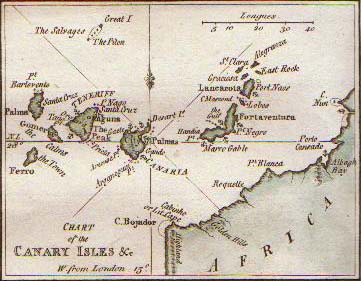|
CANARY ISLANDERS. |
 |
|||
The Canary Islanders migrated into Louisiana between 1778 and 1783. They also spread into neighboring regions. They were called "islenos" and were members of white race. Many families then moved into the eastern Texas area and then into state of Bexar as 'Anglo" pressure continued to press westward.
The Canary Islands are a collection of 7 islands about 100 miles west of
the coast of Morocco. Spaniards conquered the area and migrated to the
island in the 15th and 16th century. By the 18th century, the islands were
controlled by nobles. The main product of the slands was the production of
orchil, a lichen that produces a violet dye. When the orchil crop was low,
which happened periodically, the workers practically starved to death and
didn't receive much help from the nobles.
Since the late 1600s, Spain had encouraged the Canary Islanders to
move to the Caribbean colonies. After Spain acquired Louisiana in 1762, it
recognized the need to populate the territory. When the Revolutionary War
brought the English in conflict with the American colonies, Spain recognized
the danger from possible English hostilities in Louisiana. On August 15,
1777, Spain ordered a second battalion be formed in Louisiana. It looked
to the Canary Islands for 700 recruits. It tried to get married recruits so
that they could not only defend the area, but also populate it.
[Din, p. 15] |
Vessels carrying "islenos" to Louisiana:
SS
Sacremento
San Ignacio de Loyola
La Victoria
San Juan Nepomuceno
Other ships included:
![]() La Santa Faz
La Santa Faz
![]() El Sagrada Corazon de Jeses
El Sagrada Corazon de Jeses
![]() Fragata Llamada Margarita
Fragata Llamada Margarita
![]() SS Trinidad
SS Trinidad
![]()
Settlement Foundations in
Louisiana
1.San Bernardo de Galvez,
located on shores of the Terre-Aux-Boeuf in St.Bernard Parish.
2. Galveztown, located on shores of Amite River near Manchac in Iberville
Parish.
3. Valenzuela, located on shores of Chetimachas ( Bayou Lafourche ) in
Assumption Parish.
4. Nueva Iberia, located on shores of Bayou Tache in Iberia Parish.
![]()
The Exploits of San Bernardo de Galvez


